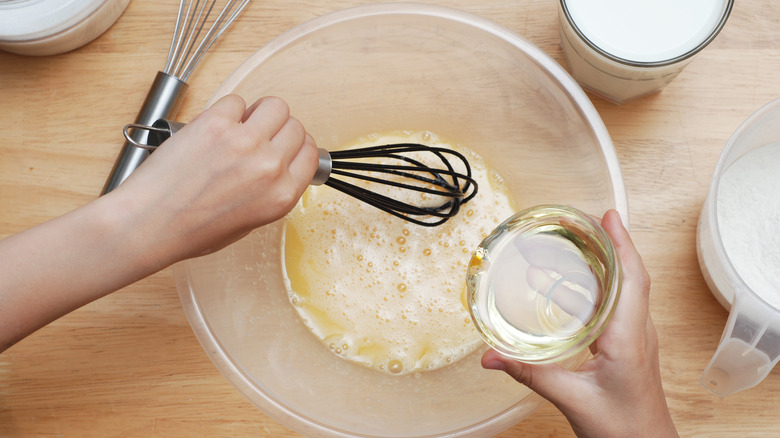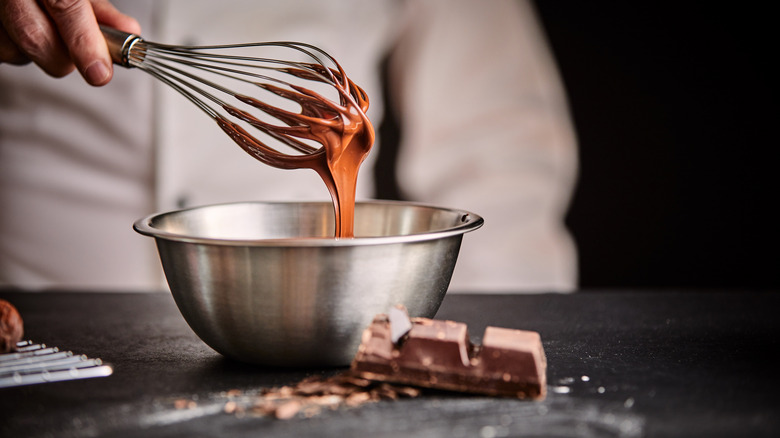The Smelly Reason You Should Avoid Using Plastic Mixing Bowls
Odors in the kitchen are not an unusual occurrence. The kitchen, after all, is where we prepare our food, throw things away and gather over a snack or a meal. Yet, even if a kitchen appears clean and spotless, there may be an unsuspecting tool that could be causing some unwanted smells in your cabinets: your plastic mixing bowl.
Plastic has a tendency to absorb ingredients, which can leave plastic bowls and Tupperware with stains and odors. Mixing bowls come in a variety of different materials, like stainless steel and glass. But while plastic is often the most cost-effective option, it may not be the best choice. In addition to lingering smells and stains, not all plastic is dishwasher- or even microwave-safe. Handwashing is the only option for keeping them clean, and you'll want to avoid hot surfaces so the plastic doesn't melt. If you have your sights set on tossing a Caesar salad with plenty of anchovies and garlic, it would be best to opt for a mixing bowl made of a less porous material.
Mixing bowls that don't stink
If you want to avoid odors, what are the best materials for mixing bowls? To start, glass is a nonporous material, so glass bowls won't stain or latch on to smells. Ceramic and metal bowls also won't run the risk of getting stinky, though each of these materials has pros and cons.
Glass, ceramic, and metal are all very durable, though ceramic bowls are easily chipped, and glass can crack even if tempered. If you're looking for a bowl that is practical while also being aesthetically pleasing — ceramic is the way to go. Ceramic mixing bowls are often offered in many different colors and textures, making them the perfect choice for anyone looking to match their tools to the design of their kitchen. If you're not interested in looks and want an inexpensive option that's longer lasting than plastic, opt for metal mixing bowls. Stainless steel bowls are classic and often used in restaurant kitchens; just be careful when adding hot ingredients, as the metal will also get hot. Furthermore, many glass bowls include special features like measuring guides, pour spouts, and lids, making them especially great for baking; glass is also quite durable.
What to consider before buying mixing bowls
With so many different options, deciding which bowls are right for you may be overwhelming. While it might simply come down to personal preference, there are a few things to keep in mind when choosing, namely how much space you have in your kitchen and what you plan to use them for.
Many mixing bowls come in a set, so you get a variety of different sizes. While it may be tempting to go for the set with the most bowls, consider how much storage space you have in your kitchen and how often you plan to use them. Most at-home chefs don't need 10 or more bowls, so stick to the few sizes you think you'll use the most.
Mixing bowls can be used for so many things, whether storing food, tossing salads, stirring batters, or marinating meat and poultry. Consider this when deciding — some may benefit from pouring spouts or lids, especially if you plan on taking your food to potlucks and gatherings. Others may prefer an attractive bowl that can move seamlessly from the kitchen to the dining table. And even though plastic bowls can become smelly over time, they are shatterproof and not very expensive, which could be precisely what you're looking for. Whatever your reason for looking to expand your kitchen tools, rest easy knowing there is a mixing bowl for everyone.


